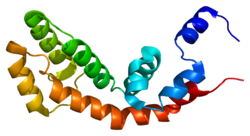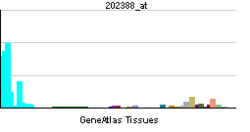RGS2
| edit |
| Regulator G-proteinske signalizacije 2 | |||||||||||
|---|---|---|---|---|---|---|---|---|---|---|---|
 PDB prikaz baziran na 2af0. | |||||||||||
| Dostupne strukture | |||||||||||
| 2AF0, 2V4Z, 4EKC, 4EKD | |||||||||||
| Identifikatori | |||||||||||
| Simboli | RGS2; G0S8 | ||||||||||
| Vanjski ID | OMIM: 600861 MGI: 1098271 HomoloGene: 2192 GeneCards: RGS2 Gene | ||||||||||
| |||||||||||
| Pregled RNK izražavanja | |||||||||||
 | |||||||||||
| podaci | |||||||||||
| Ortolozi | |||||||||||
| Vrsta | Čovek | Miš | |||||||||
| Entrez | 5997 | 19735 | |||||||||
| Ensembl | ENSG00000116741 | ENSMUSG00000026360 | |||||||||
| UniProt | P41220 | O08849 | |||||||||
| Ref. Sekv. (iRNK) | NM_002923 | NM_009061 | |||||||||
| Ref. Sekv. (protein) | NP_002914 | NP_033087 | |||||||||
| Lokacija (UCSC) | Chr 1: 192.78 - 192.78 Mb | Chr 1: 144 - 144 Mb | |||||||||
| PubMed pretraga | [1] | [2] | |||||||||
Regulator G-proteinske signalizacije 2 je protein koji je kod ljudi kodiran RGS2 genom.[1][2] On je deo velike familije RGS proteina koji kontrolišu signalizaciju putem G-protein spregnutih receptora (GPCR).
Interakcije
RGS2 formira interakcije sa PRKG1[3] and ADCY5.[4]
Reference
- ↑ Siderovski DP, Heximer SP, Forsdyke DR (Jun 1994). „A human gene encoding a putative basic helix-loop-helix phosphoprotein whose mRNA increases rapidly in cycloheximide-treated blood mononuclear cells”. DNA Cell Biol 13 (2): 125–47. DOI:10.1089/dna.1994.13.125. PMID 8179820.
- ↑ „RGS2 regulator of G-protein signaling 2, 24kDa”.
- ↑ Tang KM, Wang GR, Lu P, Karas RH, Aronovitz M, Heximer SP, Kaltenbronn KM, Blumer KJ, Siderovski DP, Zhu Y, Mendelsohn ME, Tang M, Wang G (December 2003). „Regulator of G-protein signaling-2 mediates vascular smooth muscle relaxation and blood pressure”. Nat. Med. 9 (12): 1506–12. DOI:10.1038/nm958. PMID 14608379.
- ↑ Salim S, Sinnarajah S, Kehrl JH, Dessauer CW (May 2003). „Identification of RGS2 and type V adenylyl cyclase interaction sites”. J. Biol. Chem. 278 (18): 15842–9. DOI:10.1074/jbc.M210663200. PMID 12604604.
Literatura
- Siderovski DP, Blum S, Forsdyke RE, Forsdyke DR (1991). „A set of human putative lymphocyte G0/G1 switch genes includes genes homologous to rodent cytokine and zinc finger protein-encoding genes.”. DNA Cell Biol. 9 (8): 579–87. DOI:10.1089/dna.1990.9.579. PMID 1702972.
- Wu HK, Heng HH, Shi XM, et al. (1995). „Differential expression of a basic helix-loop-helix phosphoprotein gene, G0S8, in acute leukemia and localization to human chromosome 1q31.”. Leukemia 9 (8): 1291–8. PMID 7643615.
- Druey KM, Blumer KJ, Kang VH, Kehrl JH (1996). „Inhibition of G-protein-mediated MAP kinase activation by a new mammalian gene family.”. Nature 379 (6567): 742–6. DOI:10.1038/379742a0. PMID 8602223.
- Siderovski DP, Hessel A, Chung S, et al. (1996). „A new family of regulators of G-protein-coupled receptors?”. Curr. Biol. 6 (2): 211–2. DOI:10.1016/S0960-9822(02)00454-2. PMID 8673468.
- Heximer SP, Cristillo AD, Forsdyke DR (1997). „Comparison of mRNA expression of two regulators of G-protein signaling, RGS1/BL34/1R20 and RGS2/G0S8, in cultured human blood mononuclear cells.”. DNA Cell Biol. 16 (5): 589–98. DOI:10.1089/dna.1997.16.589. PMID 9174164.
- Heximer SP, Watson N, Linder ME, et al. (1998). „RGS2/G0S8 is a selective inhibitor of Gqalpha function.”. Proc. Natl. Acad. Sci. U.S.A. 94 (26): 14389–93. DOI:10.1073/pnas.94.26.14389. PMC 24991. PMID 9405622.
- Tseng CC, Zhang XY (1998). „Role of regulator of G protein signaling in desensitization of the glucose-dependent insulinotropic peptide receptor.”. Endocrinology 139 (11): 4470–5. DOI:10.1210/en.139.11.4470. PMID 9794454.
- Beadling C, Druey KM, Richter G, et al. (1999). „Regulators of G protein signaling exhibit distinct patterns of gene expression and target G protein specificity in human lymphocytes.”. J. Immunol. 162 (5): 2677–82. PMID 10072511.
- Popov SG, Krishna UM, Falck JR, Wilkie TM (2000). „Ca2+/Calmodulin reverses phosphatidylinositol 3,4, 5-trisphosphate-dependent inhibition of regulators of G protein-signaling GTPase-activating protein activity.”. J. Biol. Chem. 275 (25): 18962–8. DOI:10.1074/jbc.M001128200. PMID 10747990.
- Zheng B, Chen D, Farquhar MG (2000). „MIR16, a putative membrane glycerophosphodiester phosphodiesterase, interacts with RGS16.”. Proc. Natl. Acad. Sci. U.S.A. 97 (8): 3999–4004. DOI:10.1073/pnas.97.8.3999. PMC 18131. PMID 10760272.
- Chatterjee TK, Fisher RA (2000). „Cytoplasmic, nuclear, and golgi localization of RGS proteins. Evidence for N-terminal and RGS domain sequences as intracellular targeting motifs.”. J. Biol. Chem. 275 (31): 24013–21. DOI:10.1074/jbc.M002082200. PMID 10791963.
- Sullivan BM, Harrison-Lavoie KJ, Marshansky V, et al. (2000). „RGS4 and RGS2 bind coatomer and inhibit COPI association with Golgi membranes and intracellular transport.”. Mol. Biol. Cell 11 (9): 3155–68. DOI:10.1091/mbc.11.9.3155. PMC 14982. PMID 10982407.
- Cunningham ML, Waldo GL, Hollinger S, et al. (2001). „Protein kinase C phosphorylates RGS2 and modulates its capacity for negative regulation of Galpha 11 signaling.”. J. Biol. Chem. 276 (8): 5438–44. DOI:10.1074/jbc.M007699200. PMID 11063746.
- Heximer SP, Lim H, Bernard JL, Blumer KJ (2001). „Mechanisms governing subcellular localization and function of human RGS2.”. J. Biol. Chem. 276 (17): 14195–203. DOI:10.1074/jbc.M009942200. PMID 11278586.
- Mittmann C, Schüler C, Chung CH, et al. (2001). „Evidence for a short form of RGS3 preferentially expressed in the human heart.”. Naunyn Schmiedebergs Arch. Pharmacol. 363 (4): 456–63. DOI:10.1007/s002100000376. PMID 11330340.
- Mittmann C, Chung CH, Höppner G, et al. (2002). „Expression of ten RGS proteins in human myocardium: functional characterization of an upregulation of RGS4 in heart failure.”. Cardiovasc. Res. 55 (4): 778–86. DOI:10.1016/S0008-6363(02)00459-5. PMID 12176127.
- Nlend MC, Bookman RJ, Conner GE, Salathe M (2002). „Regulator of G-protein signaling protein 2 modulates purinergic calcium and ciliary beat frequency responses in airway epithelia.”. Am. J. Respir. Cell Mol. Biol. 27 (4): 436–45. DOI:10.1165/rcmb.2002-0012oc. PMID 12356577.
- Strausberg RL, Feingold EA, Grouse LH, et al. (2003). „Generation and initial analysis of more than 15,000 full-length human and mouse cDNA sequences.”. Proc. Natl. Acad. Sci. U.S.A. 99 (26): 16899–903. DOI:10.1073/pnas.242603899. PMC 139241. PMID 12477932.
- Cho H, Harrison K, Schwartz O, Kehrl JH (2003). „The aorta and heart differentially express RGS (regulators of G-protein signalling) proteins that selectively regulate sphingosine 1-phosphate, angiotensin II and endothelin-1 signalling.”. Biochem. J. 371 (Pt 3): 973–80. DOI:10.1042/BJ20021769. PMC 1223344. PMID 12564955.
- p
- r
- u
PDB Galerija
|







